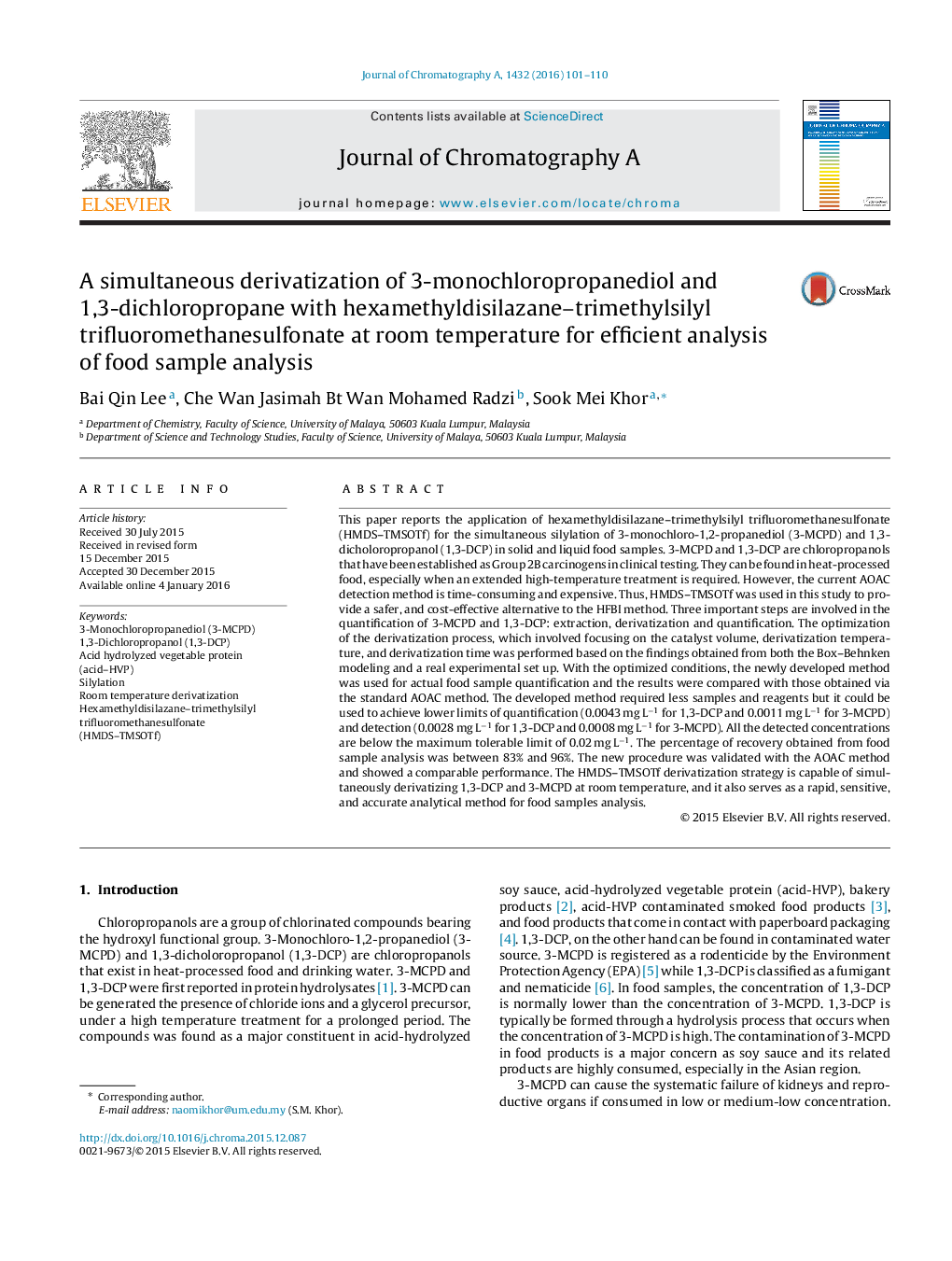| کد مقاله | کد نشریه | سال انتشار | مقاله انگلیسی | نسخه تمام متن |
|---|---|---|---|---|
| 7610299 | 1493494 | 2016 | 10 صفحه PDF | دانلود رایگان |
عنوان انگلیسی مقاله ISI
A simultaneous derivatization of 3-monochloropropanediol and 1,3-dichloropropane with hexamethyldisilazane-trimethylsilyl trifluoromethanesulfonate at room temperature for efficient analysis of food sample analysis
دانلود مقاله + سفارش ترجمه
دانلود مقاله ISI انگلیسی
رایگان برای ایرانیان
کلمات کلیدی
موضوعات مرتبط
مهندسی و علوم پایه
شیمی
شیمی آنالیزی یا شیمی تجزیه
پیش نمایش صفحه اول مقاله

چکیده انگلیسی
This paper reports the application of hexamethyldisilazane-trimethylsilyl trifluoromethanesulfonate (HMDS-TMSOTf) for the simultaneous silylation of 3-monochloro-1,2-propanediol (3-MCPD) and 1,3-dicholoropropanol (1,3-DCP) in solid and liquid food samples. 3-MCPD and 1,3-DCP are chloropropanols that have been established as Group 2B carcinogens in clinical testing. They can be found in heat-processed food, especially when an extended high-temperature treatment is required. However, the current AOAC detection method is time-consuming and expensive. Thus, HMDS-TMSOTf was used in this study to provide a safer, and cost-effective alternative to the HFBI method. Three important steps are involved in the quantification of 3-MCPD and 1,3-DCP: extraction, derivatization and quantification. The optimization of the derivatization process, which involved focusing on the catalyst volume, derivatization temperature, and derivatization time was performed based on the findings obtained from both the Box-Behnken modeling and a real experimental set up. With the optimized conditions, the newly developed method was used for actual food sample quantification and the results were compared with those obtained via the standard AOAC method. The developed method required less samples and reagents but it could be used to achieve lower limits of quantification (0.0043 mg Lâ1 for 1,3-DCP and 0.0011 mg Lâ1 for 3-MCPD) and detection (0.0028 mg Lâ1 for 1,3-DCP and 0.0008 mg Lâ1 for 3-MCPD). All the detected concentrations are below the maximum tolerable limit of 0.02 mg Lâ1. The percentage of recovery obtained from food sample analysis was between 83% and 96%. The new procedure was validated with the AOAC method and showed a comparable performance. The HMDS-TMSOTf derivatization strategy is capable of simultaneously derivatizing 1,3-DCP and 3-MCPD at room temperature, and it also serves as a rapid, sensitive, and accurate analytical method for food samples analysis.
ناشر
Database: Elsevier - ScienceDirect (ساینس دایرکت)
Journal: Journal of Chromatography A - Volume 1432, 5 February 2016, Pages 101-110
Journal: Journal of Chromatography A - Volume 1432, 5 February 2016, Pages 101-110
نویسندگان
Bai Qin Lee, Che Wan Jasimah Bt Wan Mohamed Radzi, Sook Mei Khor,